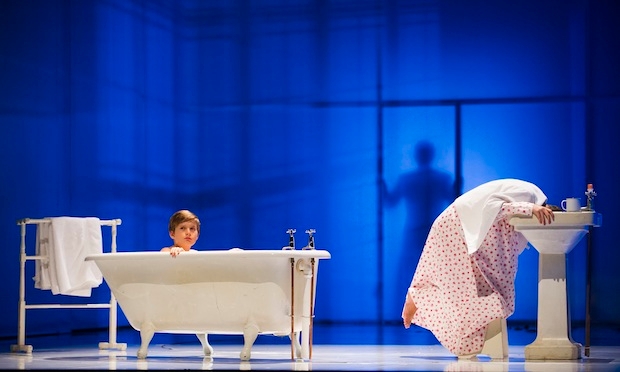We all know that ‘They fuck you up your mum and dad’, but nowhere is this more reliably (and violently) true than in the opera house. If you have the misfortune to be born into an operatic family you can expect to be murdered by your own mother (Médée, Lucrezia Borgia), killed by your grandmother (Jenufa), or even bumped off by a hitman hired by your father (Rigoletto).
Perhaps most insidious, however, are the crimes not of violence but of absence, neglect rather than active cruelty. Productions of Verdi’s I due Foscari and Britten’s The Turn of the Screw whispered some of the darkest unspokens of parent-child relations, conjuring nightmares all the more potent for their subtle horrors.
Britten’s ‘curious story’ of a governess caring for two orphaned children in a remote house is a miracle of taut construction. Running at less than two hours, with a cast of six and an orchestra of just 13, its slender precision mirrors Henry James’s original. But Britten’s musical narrative has a built-in device denied to the prose-bound James. Constructed around a single theme, the work unfolds in 15 variations, each ‘turning the screw’ just a little tighter on this single idée fixe. In Jonathan Kent’s endlessly inventive production for Glyndebourne (originally seen in 2006), these variations go from musical transitions to the dramatic engine driving this domestic tragedy to its terrible conclusion.
The cosy 1950s naturalism of Paul Brown’s set is framed by a double, circular revolve. Almost perpetually in motion, propelling beds and baths, children and their ghostly doubles into and out of view, it suggests unseen agency. At its centre is a giant glass panel which twists and shifts with each changing scene. Endlessly reinventing itself, first greenhouse, now French windows, then frozen lake, it remains always a membrane — increasingly and terrifyingly porous — between two worlds. Whether these are worlds of sanity and madness or safety and danger remains deliberately unclear as they merge and bleed into one another, echoing the governess’s own question: ‘Is this sheltered place the wicked world, where things unspoken of can be?’

Elegant though Kent’s production is, Britten’s opera stands or falls with its cast. Achieving a rare natural chemistry, the children — Flora (Louise Moseley) and Miles (Thomas Delgado-Little) — dominate. So familiar, so instinctive is their play that it loads the dice even more heavily than usual against the governess (Natalya Romaniw) and her suspicions. A brilliant coup de théâtre finds them playing in the dirt of a fresh grave, ripping petals from a wreath — horrors of the sweetest, most innocent kind imaginable.
If all eyes are on the children, all ears are on the adults of the cast. Anthony Gregory’s Quint is exquisitely sung, his villain all the more disturbing for his vocal beauty. He’s paired with an explosive Miss Jessel (Miranda Keys), whose vocal dramatics contrast with Romaniw’s matter-of-fact delivery — only hinting at hysteria in the very final moments — and an unusually robust Mrs Grose from Anne Mason.
On careful inspection, film footage used in the Prologue reveals itself shot in Glyndebourne’s own gardens. We may watch Bly’s tragedy from the safety of the audience, but shouldn’t kid ourselves that we’re safe from its horrors. It’s the final and cruellest twist for a Screw that’s tightly wound indeed.
At the Royal Opera House, unfortunately, nightmares were more artistic than psychological. I due Foscari opens with all the subtlety of a slasher film in crashes of minor-key brass and a solo clarinet that extends a stockinged leg seductively from behind the curtain of the orchestral texture. Barring a striking Act II prelude for solo cello and viola, it only gets less subtle from here. Verdi might have grown into a master painter of the more delicate shades of human relationships, but here in his sixth opera he’s still very much the apprentice.

Which is a shame, because the central conceit of Foscari is an interesting one. Political power and paternal duty come to blows when the elderly Doge of Venice, Francesco Foscari (Plácido Domingo), must choose between interceding to save his innocent son, Jacopo Foscari, and clinging to his authority. Composed not long after Verdi himself lost his wife and two children to illness, it’s a concept that should resonate strongly, but which, in Thaddeus Strassberger’s baffling, conservative production, is more dull thud than emotional echo-chamber.
The director sets himself the impossible task of marrying attractive visuals with a sense of pervasive decay. The result is a 15th-century-lite Venice that lurches from carnival fire-eaters and acrobats to torture chambers and dank caverns. Neither style nor substance are served, and why Lucrezia’s waiting women are attired like diaphanous Klan members, or why their mistress suddenly sets about murdering her children in the final moments (with no encouragement from the score) is anyone’s guess.
The reason for this theatrical carnival? Domingo, of course, who continues his new life as a baritone in the plum role of the Doge. A star vehicle needs a star, and if Domingo still has a watchable urgency about him then it’s far from the radiance his famous bronze tone used to exert. It’s left to rising tenor Francesco Meli to step into the breach as son Jacopo, aided (when nerves don’t send things awry) by soprano Maria Agresta as his wife.
This production promises two Foscari and sends us home with one and a half. Even by Venetian standards, that’s a swindle.






Comments